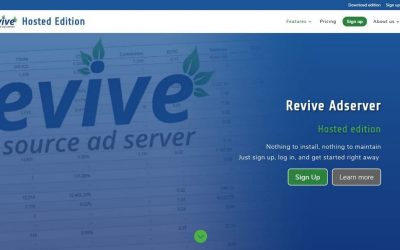Finetuning subscription renewals, overage use and pricing plan switches
We’re introducing a few practical changes to how we will deal with failed renewal payments, with payment for overage use, and with how we will process pricing plan switches when accounts have an increase or decrease in their monthly ad volume.
Background
Revive Adserver Hosted edition was first introduced in September 2018, and in these first 5 years, we’ve seen a steady increase in the number of active subscriptions. At the start of the service, we designed a pricing model that works for very small and very large operations alike. All our pricing plans are outlined in detail at our pricing page.
Initial subscription order and renewals
When a new subscriber joins, they pay a prorated amount for the remaining number of days in the current month. For example, when somebody joins on September 16 for the Lite pricing plan, they will pay for the 15 remaining days of a 30 day month at $10 for a full month, so that comes down to 15/30 or ½ of $10 = $5.
Then, on the first calendar day of the next month, a renewal payment for the full amount of the selected pricing plan is charged. So to follow the example above, this subscriber will be charged $10 for the Lite plan for October. Their next renewal is due on November 1st, then December 1st, and so on.
These practices for new subscriptions and monthly renewals will remain the same.
Failed renewal payments
It happens from time to time that a renewal payment fails initially. This can have several reasons. For example, the card that was used when creating the subscription has expired, or the card is over its spending limit. Typically, about 5% or all renewal payments fail on the first attempt. This is a common percentage across many industries that work with monthly renewals.
Our system for processing renewal payments doesn’t give up right away, it will retry to collect the payment 12 hours later, another 12 hours later, 24 hours later, 48 hours later, and finally 72 hours later. So in total, there can be up to 6 attempts to collect the payment over a period of 7 days. With the second and the fourth attempt, it also sends an email to the subscriber alerting them of the problem with their card, and urging them to manually complete the payment, perhaps even using a new or different card.
If the renewal payment still hasn’t been completed one week after it was due, one of the team members responsible for Revive Adserver Hosted edition will also manually check all failed renewal payments and send additional warning messages to subscribers that have a failed renewal payment. This process is almost entirely automated but it does involve a human check. If payments are still not completed, we sometimes contact subscribers by email asking them to complete their renewals.
Ultimately, we may end up suspending or even cancelling the subscription and the corresponding ad server account if the renewal payment is overdue for more than 7 days.
What’s changing?
Starting in October 2023, we will implement a more strict procedure regarding failed renewal payments. If the renewal payment fails and then the next 3 attempts also fail, a very clear warning will be sent to the subscriber by email. This message will explain that if the payment is not completed by the 4th day, the ad server account will be suspended immediately and without an additional warning. It will be restored following a successful payment. If the payment is not yet completed by the 7th day, we may end up cancelling the subscription entirely and deleting the ad server account.
The reason for this somewhat more strict process is that we’ve noticed that a very small number of subscribers tends to be causing us an unreasonable amount of work, which is frustrating for our team members and reduces the time they can spend on other, more productive work. The vast majority of subscribers will not be affected and won’t even notice anything different, because their renewal payments automatically complete on the first attempt, or upon one of the first retries.
Overage use payments
For every pricing level, there is a corresponding number of monthly ad requests included. For example, the Lite plan, which costs $10 per month, includes up to 1 million ad requests per month, and the Plus plan, which costs $20 per month, includes up to 2 million ad requests per month. All our pricing plans are outlined in detail at our pricing page.
The vast majority of subscribers remain below the maximum number of ad requests that their selected pricing level allows for. But in a small number of cases, subscribers have a higher number of ad requests then their pricing level allows for. We call this “overage use”.
After each calendar month, we run a process to charge this overage use to the subscriber’s card. For example: a subscriber at the Lite pricing level ($10 a month for up to 1 million ad requests per month), may end up with 1.4 million ad requests in a given month. We will then charge an overage use of $4 to their card. That’s because the overage use of 0.4 million ad requests corresponds to 40% of their monthly amount.
There is only a small number of accounts that have overage use, too small to justify the investment of completely automating the process. We also manually check each case to make sure that we aren’t overly vigilant. For example, when a Lite subscriber has 1.01 million ad requests in a month, we won’t charge a $0.10 overage fee (and most card companies won’t process such small amounts anyway). On the other hand, with the total number of subscribers growing month after month, the number of cases of overage use also increases, resulting in more and more work for our team.
At the same time, there is also a level of unfairness in this approach. A subscriber at the Plus pricing level ($20 for up to 2 million ad requests per month) may end up with 1.5 million ad requests, and have paid $20 for that. Another subscriber at the Lite pricing level ($10 for up to 1 million ad requests), also ending up with 1.5 million ad requests in that month, will have paid only $15 for that.
What’s changing?
Starting in October 2023, we’ll be changing some things on how we deal with overage use:
- The rate for overage use will change from $10 per unit of 1 million ad requests to $20 per unit of 1 million ad requests.
- The overage use we calculate and charge will never be higher than the difference between the current and the appropriate pricing level.
- Overage use costs will be rounded up to the nearest whole dollar.
Two examples:
- A subscriber at the Lite pricing level ($10 for up to 1 million ad requests) ends up with 1.4 million ad requests, that means there’s an overage of 0.4 million ad requests. The overage charge used to be $4 but that will change to $8.
- Another Lite subscriber ends up with 4.7 million ad requests, so an overage of 3.7 million ad requests. The overage charge used to be $37, and instead of doubling that to $74, it will change to the maximum of $40 for this scenario. Effectively this subscriber has paid $50 for that month, the same as someone who has the Premium pricing plan selected.
The reason for this changed approach is that it helps cover the costs involved in processing overage use charges, while at the same time making things more fair for all subscribers. The vast majority of subscribers won’t be affected by this change, since they stay well within their allocated number of monthly ad requests.
Upward switching of pricing levels
It happens from time to time that a subscriber outgrows their selected pricing level. When this happens, we send them a message by email requesting them to switch to a higher pricing level that matches their usage. Unfortunately, about 75% of times when we send such a request, the subscriber doesn’t act, and then we have to urge them one or more times until they act. In some cases we even have to manually intervene and switch their subscription to the appropriate level on their behalf.
We’ve surveyed a group of subscribers for whom the pricing level was switched upward, either by themselves or by us on their behalf, and over 70% of respondents indicated that they preferred if such switches would be implemented automatically, without having to spend time on it. A large majority said that they would like to be informed about such a change in advance.
What’s changing?
Starting from October 2023, we will make a change to this procedure of pricing plan switches. When a subscriber has had 3 months of overage use charges (see the previous section), we will send them a message announcing an upcoming pricing level change, and then we’ll implement the change on their behalf from the system backend.
Downward switching of pricing levels
At the same time, we also have subscribers that consistently use far fewer ad requests than their pricing level allows for, meaning that they would be better off financially by having a lower pricing level. At regular intervals, we send out messages to these subscribers, recommending them to switch their subscription to a smaller pricing plan. We also have subscribers, almost always at the smallest $10 pricing level, that do not use their ad server account at all. From time to time, we send them a message to recommend cancelling their subscription altogether.
In virtually all cases, subscribers do not follow these recommendations, which might sound strange. But we’ve heard many times, when we contact subscribers to follow up, that they have subscribed as a form of donating to the Revive Adserver open source project, to say thanks for the software they use to self-host their own ad server.
Therefore, we will not make any changes to the pricing level of subscribers that have a subscription that is larger than what their actual usage requires.
The only exception is when a subscription that we’ve upgraded automatically as a result of the process described in the previous section, is subsequently dropping in usage again. If they’ve had 2 months with a volume that’s less than their active pricing plan, we will automatically switch their subscription back to a more appropriate smaller pricing plan
This automatic pricing plan switch approach will affect only a very small portion of our subscribers. The vast majority of our subscribers have a relatively steady activity level. Those that have seasonal patterns or occasional spikes are better off with a subscription that automatically follows their peaks and valleys in activity.
Timeline of these changes
All the changes described above will come into effect on October 1st, 2023. These are merely practical changes that are in perfect alignment with our existing Terms & Conditions that have been in place since the very beginning of our service and that won’t change.
We will inform all existing subscribers about the upcoming practical changes by placing a link to this blog post in the payment confirmation email for the October 1st renewal payment. We will also add notes and clarifications to the pricing page on this website.
What’s not changing?
It should be noted that we’re not making any changes to the pricing and rates for the Revive Adserver Hosted edition service.
Just like every person, household, and organization, we’ve been confronted with inflation. But the growth in our subscriber base has resulted in sufficient economies of scale to enable us to absorb these cost increases without having to increase the base rate for our subscribers.
The same low rate of $10 per unit of 1 million ad requests remains in place, as it has been since the start in late 2018.



